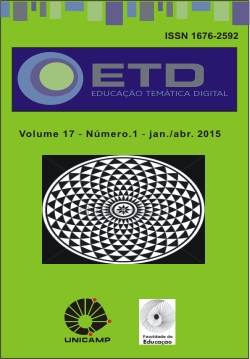Resumo
This article discusses the different ways of using photography as a research method in social sciences, especially how using participatory photography with young people and children is explored. The advantages of making teenagers and children co-researchers as well as some of the issues that emerge, like lack of control over the data collection and ethical issues, are examined. A case study on language minority teenagers’ identifications with and sense of belonging to the language minority group is offered as an example of participatory photography. The interplay between the photographs and the texts produced by the teenagers exemplify the necessity of using several kinds of data instead of only photographs.
Referências
BANKS, Marcus. Visual methods in social research. London: Sage, 2001.
BATESON, Gregory; MEAD, Margaret. Balinese character. A photographic essay. New York: New York Academy of Sciences, 1942. v.2.
CAPONIGRO, John Paul. Illuminating creativity. Available:
http://www.johnpaulcaponigro.com/photographers/quotes/joyce-tenneson/
COLLIER Jonh. Jr.; COLLIER, Malcom. Visual anthropology. Photography as a research method. Albuquerque: Univ. of New Mexico, 1986.
FLICK, Uwe. An introduction to qualitative research. Thousand Oaks, CA: Sage, 2002.
GRADY, John. The scope of visual sociology. Visual sociology, v.11, n.2, p.10-24, 1996.
HARPER, Douglas. Photography as social science data. In FLICK, Uwe (ED.); KARDOFF, Ernest von (ED.); STEINKE, I. (ED.). A companion to qualitative research. London: Sage, 2004. p. 231-236. www.fae.unicamp.br/etd
HO, Wing-Chung; ROCHELLE, Tina Louisa; YUEN, Wing-Kan. “We are not sad at all”: adolescents talk about their “city of sadness” through photovoice. Journal of Adolescent Research, v. 26, n.6, p.727-765, 2011.
HOLM, Gunilla. Handled but not heard: the managed lives of teenage mothers. International Journal of Qualitative Studies in Education, v. 87, n.3, p.253-254, 1995.
HOLM, Gunilla. Teenage motherhood: public posing and private thoughts. In: Paley, N.(ED.); JIPSON, J. (ED.). Daredevil research. New York: Peter Lang, 1997. cap. 4. p.61-81.
HOLM, Gunilla. (2008a). Photography as a performance [34 paragraphs]. Forum qualitative sozialforschung/forum. Qualitative Social Research, v. 9, n.2. Available: http://nbnresolving.de/urn:nbn:de:0014-fqs0802328
HOLM, Gunilla. Visual research methods: where are we and where are we going? In: HESSE-BIBER, S.; LEAVY, P. (Eds.), Handbook of emergent methods. New York: Guilford, 2008b. p. 325-341.
HOLM, Gunilla. (2014). Photography as a Research Method. In: P. Leavy (Ed.), Oxford Handbook of Qualitative Research. Oxford: Oxford Univ., 2014. Cap. 19.
HOLM, Gunilla.; LONDEN, Monica; MANSIKKA Jan-Erik. Interpreting visual (and verbal) data: teenagers’ views on belonging to a language minority group. In: SMEYERS, Paul; BRIDGES (ED.), David (ED.); BURBULES, Nicholas (ED.); GRIFFITHS, Morwenna (ED.), International Handbook of Interpretation in Educational Research Methods.Dordrecht: Springer, 2015. p. 753-781.
JUTILA, Vesa. DIGITALK CONFERENCE, 2012, Sofia, Bulgária, 2012.
LODGE, Caroline. About face: visual research involving children. Education, v.37, n.4, p.3-13, 2009.
MARQUEZ-ZENKOV, Kristien et al. If they listen to us about life, we’ll listen to them about school: seeing city students’ ideas about “quality” teachers. Educational Action Research, v.15, n.3, p. 403–415, 2007.
NEWMAN, Michelle; WOODCOCK, Andree; DUNHAM, Philip. Playtime in the borderlands: children’s representations of school, gender and bullying through photographs and interviews. Children’s Geographies, v.4, n.3, p. 289–302, 2006.
PINK, Sarah. Doing visual ethnography. London: Sage, 2007.
PROSSER, Jon. What constitutes an image-based qualitative methodology? Visual Sociology, v.11, n.2, p.26-34, 1996.
SERRIERE, Stephanie C. Carpet-time democracy: digital photography and social consciousness in the early childhood classroom. The Social Studies, v.101, p.60-68, 2010.
WARREN, Carol A. B.; KARNER, Tracy Xavia. Discovering qualitative methods. Field research, iterviews, and analysis. Los Angeles: Roxbury, 2005.
VEINTIE, Tuija; HOLM, Gunilla. The perceptions of knowledge and learning of Amazonian indigenous teacher education students. Ethnography and Education, v.5, n.3, p.325-343, 2010.
A ETD - Educação Temática Digital utiliza a licença do Creative Commons (CC), preservando assim, a integridade dos artigos em ambiente de acesso aberto.


